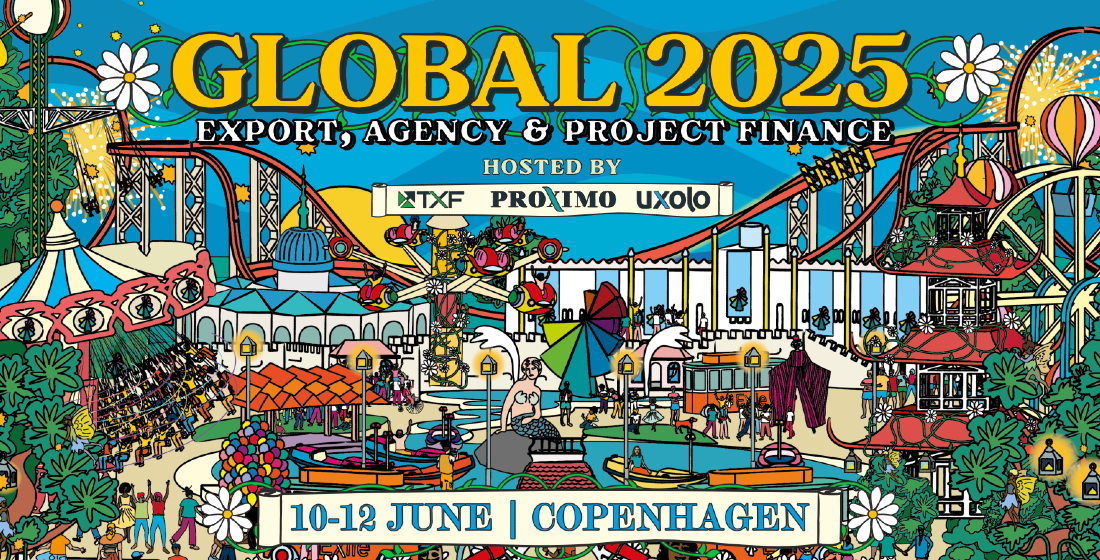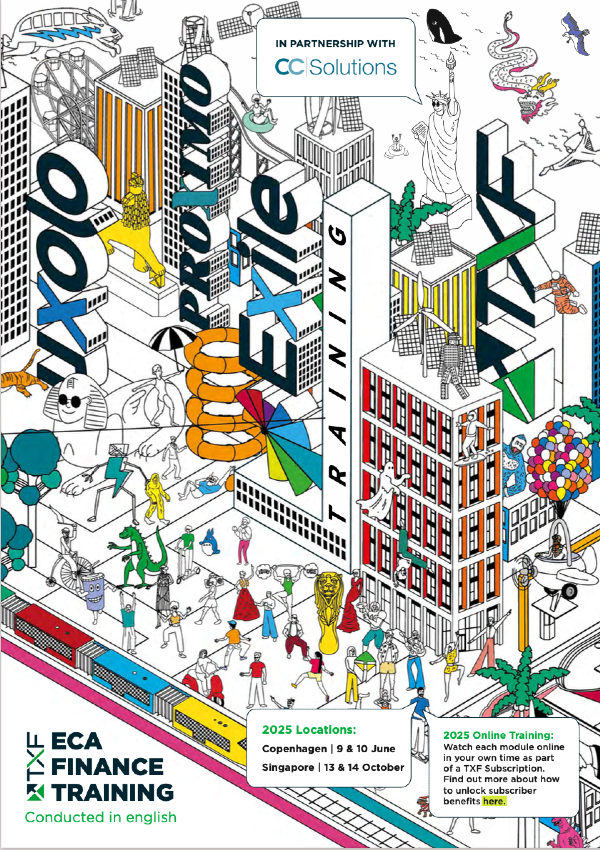Shop talk: Citi’s head of commodity and energy trade talks strategy
TXF spoke to Christine McWilliams, global head of commodity and energy trade at Citi about the bank’s longer term strategy after a decade back in the commodity markets. Amid the crisis in Ukraine, and with demand resurgent, supply dislocations and commodity prices at record highs, banks are facing challenges of how to finance commodity markets. Can ESG and digitisation plans stay on track too?

TXF: These are interesting times in the commodity markets. Can you tell me about yours, and Citi’s, role in commodities finance?
 Christine McWilliams (CMW): This year is special for me because it’s the 10 year anniversary of Citi being in the commodity industry. I'm particularly thrilled and proud of where our franchise is today. We launched our commodity industry and commodity trade finance (CTF) business in 2012. We've grown, and particularly relevant, we've stayed steady. We continue to carefully and thoughtfully grow the business. It's always been a fascinating industry and there's always something new and different happening.
Christine McWilliams (CMW): This year is special for me because it’s the 10 year anniversary of Citi being in the commodity industry. I'm particularly thrilled and proud of where our franchise is today. We launched our commodity industry and commodity trade finance (CTF) business in 2012. We've grown, and particularly relevant, we've stayed steady. We continue to carefully and thoughtfully grow the business. It's always been a fascinating industry and there's always something new and different happening.
I’m proud we've stayed the course and have done in this industry what we try to do elsewhere, which is when we commit to our clients, we try to follow through. It's amazing, or maybe appropriate, given so much is going on in the world. It certainly has not been a boring tenure!
TXF: In these turbulent markets, what is particularly interesting you in 2022?
CMW: With commodity prices at all-time highs across the board and banks making strategic selective decisions around how they want to finance the industry, it adds a nuance to the financing space. ESG [environment, social and governance] is a big topic for us, and so is digitisation. Then, of course, there is the topic of global demand coming back online and amid geopolitical considerations.
TXF: In terms of the current geopolitical situation, particularly in Ukraine, how will that impact your strategy going forward?
CMW: The geopolitical overlay in the commodity space is always a factor. We have interest rates coming up, and high commodity prices because supply is challenged in most commodities as well as demand coming back online. Overlaying that is the geopolitical events. How all four of those factors will work out will tell us where commodity prices will head long term, and then also how we as financiers need to respond to support our clients because our clients in different parts of that value chain will need different things.
Our challenge is to look ahead and see how several of these things might work out and start to think now for each of our clients through the value chain, what might they ask you to do in 90 days’ time? And how can I get ready for that today?
TXF: Are discussions of commodity supercycles relevant now?
CMW: Whether there's a supercycle or not is not a very interesting debate for me. The fact is, commodity prices are at an all-time high and we need more supply, and demand is coming on. Whether you think it's a supercycle or not, we'll look back in several years and decide. Calling it something doesn't change the day to day of what we have to do or our clients have to do. Back last fall, maybe we thought it was a supercycle but now we're in such a unique situation with so many other unique qualities that I think this is something different.
TXF: On the strategic side, commodity markets have been a rollercoaster over the last year, but over the last 10 years for investment banks, generally, many had drawn back from financing commodities while Citi appeared to go the opposite direction. You've been forming a ‘supergroup’ within commodities. How's that strategy going to improve your risk and regulation side of things as well?
CMW: Banks that have traditionally been in this space have in the past several years looked at their strategy and made some decisions on how they wanted to face the market. Interestingly, we had done the same back in 2012 when we launched our CTF business. We started with a strategy of how we wanted to face the market and grow 10 years ago, and we've stuck to it and continue to believe [it] will work for us.
We started 10 years ago in financing energy commodities, then we added metals and then softs. We started with a product slate around the three core CTF products that the industry knows well. And we have also offered Citi’s full trade solution suite.
We've chosen the clients that we wanted to partner with based on a framework on how we would approach the market to ensure consistent and quality service, and there are a lot of really fantastic clients in the market that are not Citi clients just because they didn’t happen to meet our framework where we felt we could deliver.
We had to make choices around where to put our balance sheet early because we couldn't serve everyone. We’ve continued to implement the framework, and it served us very well and it's allowed us to continue to thoughtfully add clients every year. I am pleased at how stable and steady our franchise has been growing in the commodity industry, especially given the events of late.
TXF: On the energy side are you going to be rebalancing your portfolio on oil or gas in terms of financing? And if so, what sort of balance should we be expecting?
CMW: We've announced our perspective on ESG as a firm. We publish an ESG strategy and we measure ourselves against that. And as part of that, we have made comments about financing the energy space. Of course, that impacts our traders as well. That includes our perspective on coal and our perspective on drilling in the Arctic Circle, for example. I don't expect those things to change.
One thing that we've added is we are now focusing even more on the clean energy transition. We are trying to approach ESG from three angles. We have our strategy for our own footprint, then we are supporting our traditional energy clients who are investing in strategies to move towards a clean energy transition and we have also established a new Clean Energy Transition Group that is specifically seeking companies that we believe can make a material difference.
TXF: Is your ESG strategy making difference on energy transition yet – for instance are you making distinctions between financing metallurgical coal and thermal coal within your transition matrix?
CMW: We are taking a close look at what we are financing and we're are eager to work with clients to set KPIs around the their carbon footprint, and even if they don't set a formal KPI in a facility, to at least have the discussion of what that impact is and then how we may move towards that.
We often have conversations in the energy industry around supplier finance and specifically around sustainable supplier finance, which is geared towards ESG. Whether the client chooses to start there, or they choose to start a more traditional SCF programme and add ESG as a component later, either way is fine as long as we have an agreed journey where we are supporting them. We have seen a number of times where we have started a supplier beneficial programme, not just supplier finance, but across dynamic discounting and our documentary services programmes, which also can support supplier payments, where we start with a more traditional programme and the client comes back later and we add a diversity and inclusion programme, or we add an environmental or an ESG impact-type nuance on top.
That’s becoming more common – to start a programme and then add ESG – and it is fine as the industry is in a transition. Embedding a new ESG strategy is a cultural change. It’s a bit like the transition when we first started recycling. Now you'd feel so guilty to throw something in the wrong bin because it is a habit to think about that differently. We’re all forming new habits and we're thinking in new ways. It's a step by step process.
TXF: How are you working with clients to find mutually acceptable solutions to improve sustainable production and trading processes?
CMW: We’re having frequent conversations around digitisation and ESG. They overlap quite a bit in the trading space, and across energy and commodities, because key to having an ESG programme is to measure and then report on that data.
In order to do that, you have to actually be able to collect the data. One of the challenges that we're seeing on the ‘E’ part of ESG is that often technology systems with the data were not designed to collect ESG data in a way that is now desired for reporting.
In the ‘S’ (social) piece, organisations may be able to easily track, for example, how many women a company has on its board of directors, or how many women are employed. But there could be other ESG data where we might like to collect ‘what is the carbon footprint across this whole producing field or mine?’ and thus questions such as ‘How do I measure that? What systems and equipment do I need to accurately collect and report that data?’ are being considered. In the physical commodity trading space, an example could be where a cargo is purchased directly from a producer and the trader might like to know the full end-to-end carbon footprint of that purchase from production to delivery.
We're all thinking through how to collect and then report this data. We'd all like it to move faster. It is important to recognise that the measures that we may see today are a starting point and in two to three years, we may see these measures becoming more specific because of the way we collect the data and the systems that are used may have migrated. Technology change takes investment and time. In a year or two, the data might be organised differently, and so the KPIs and the reporting will be different too. I'm just glad we're starting.
TXF: Is some of the tangible digitisation progress made in the commodity space also tracking ESG-related data? For instance, platforms like Komgo.
CMW: I sit on the board of Komgo and in addition to that shareholding, there are other high quality Fintechs that Citi has partnered with. Pre-COVID, it is my view that for most, digitisation efforts started as an idea around efficiency and data accuracy. Then for the commodity industry, over the last several years digitisation also took on an anti-fraud feel as well.
It’s still early days as the industry starts to get used to new processes and technologies. The industry is now already starting to think forward into the fact it will have data that could be really valuable for ESG reporting or monitoring. Invoice data around suppliers and payments could be analysed in a unique and different way for business value, ESG or otherwise.
For instance, a supplier that has paid its invoices on time for years and then suddenly doesn’t could be an interesting signal to investigate both for lenders in a borrowing base and for the trader using, for instance, Komgo to monitor a borrowing base.
How are my clients going to want to use this collection of data and leverage it in new and different ways? One of those is ESG sustainability, and another will be looking deeper into the supply chain.
With respect to digitisation of trade flows, there are areas that are more difficult to track. For instance, there are challenges around data due to inconsistencies of documentation by jurisdiction. For example, the form of a warehouse receipt can look different in different countries and in fact, it can look different by warehouse company. There are challenges with electronic bills of lading. And different jurisdictions regard different documents as title documents. It still starts with paper – from the farmer or producer onwards.
As we learn new habits and new ways of working there must be confidence that the technology is reliable. Transition takes time. By way of an analogy, I've used electronic boarding passes for flight after flight after flight. It's always worked for me. So I'm fine to not have my paper boarding pass now.
We're seeing that cultural transition to digital processes and documents in trade, and then juxtapose that with the sunk cost of tech investments which can slow desire for new tech spend. And then last, those differences by legal jurisdiction.
TXF: In terms of your own role, do you still get involved in structuring deals?
CMW: It's wonderful to have a global view across the industry, and I really enjoy working with the teams around the world and with clients supporting those global flows. But the most thrilling part is still working with clients on some of the more challenging deals and some more unique first-time structures. And then there’s our focus on the clean energy transition which I find fascinating.
TXF: What are the particular challenges of the clean energy transition deals?
CMW: Often they are for companies with capital structures that need to be transitioned so that the client can access additional liquidity to grow. Those capital structures may have been appropriate for a very nascent startup but as the company seeks growth, the capital structure often needs to be adjusted. The other challenge for banks in clean energy transition is that these companies tend to straddle several industries. The third challenge is they have got to be able to tap into financing interest in order to have liquidity to grow.
TXF: Would they be supply chain finance (SCF) clients too?
CMW: They could be suppliers in a SCF programme so that is certainly possible. Usually because of the situation that these companies are in, their greater need is for some kind of direct funding structure, such as a secured revolver, as opposed to a working capital enhancement structure like SCF. It's usually a more direct impact to their capital structure that they're looking for.
With respect to the clean energy transition and our supermajor clients, they have all of this talent and infrastructure, and access to a pool of capex which is meaningful to making an impact. And they're all thinking through different strategies to do that. When they decide on a strategy, they make an impact because of their size and scale. It’s amazing that we can be a part of that journey.
And our traders can make a real impact when they decide to invest in an LNG project or a hydrogen project. It makes a real difference when they decide that they want to buy metals that have to meet certain [sustainability] KPIs. It sends a signal to the market. They're making changes, and that's incredible for this transition. And then you look at Citi’s Clean Energy Transition Group whose clients, we believe, also are positioned to make a difference in the market in an innovative way.
I haven't had this much fun in the energy industry for as long as I’ve been in it. This is truly one of the best times to be in energy. If you wanted to do something new and different, if you want to make a difference in the world, if you want to be in history textbooks, this is the space to be in right now.
Christine McWilliams will be speaking at TXF’s Global Commodity Finance 2022 event in Amsterdam 10-11 May 2022.






